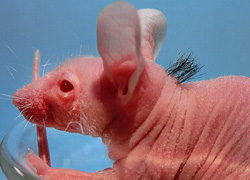
The hairs on the neck of this hairless mouse were bioengineered
Scientists in Japan have conducted animal research that may result in treatments for balding within a decade, using bioengineered stem cells. A study in Nature Communications described how experimental organ replacement regenerative therapy research resulted in hair growing on bald mice.
In the study, stem cells from hair follicles of typical mice were implanted into the skin of bald mice. Within 2 to 5 weeks, most of the hair grew in. These hairs behaved normally, in that they followed the hair growth cycle (growth, shedding, dormancy, regrowth). The scientists tested this by pulling out hair to see if it would re-grow, and it did. Just like natural hair , the hairs that resulted from the transplants made connections to nerves and muscles under the skin.
This process sounds simple, but it is actually far more complicated than just injecting a few cells. The process involved extracting, isolating, and bioengineering pelage and vibrissa follicle germ. The pelage and vibrissae are reconstituted with embryonic skin-derived cells and adult vibrissa stem cell region-derived cells, respectively.
This research was on mice, but humans are far more concerned about their hair. Embryonic stem cell research using human tissue in restricted or under threat of restriction in many countries. Many ethical issues surround the use of human embryos.
One of the researchers commented (most likely regarding male pattern balding), “If there is still hair on the back of the head, then it’s possible to use the cells from that, bio-engineer it, and regenerate new hair.”
The researchers also tried implanting hair-related cells from humans in mice, which grew fur on the bald mice. They are exploring the possibility of adjusting the density and color of the hair. This may lead to a cure for grey hair and solve other hair styling issues.
The magnitude of the risks of bioengineering, or genetic modification, is unknown. Unless hair loss is life-threatening (which is never), natural treatments should be tried first. Today, the only permanent solution for hair loss is a hair transplant. Genetic modification is not involved – the hairs are simply moved from one part of the scalp to another. An effective nutritional approach to hair loss is Dr. Shapiro’s Help Hair® Shake, which has been shown to help hair transplants grow in more quickly and make hair appear thicker, shinier and more lustrous.
Study: “Fully functional hair follicle regeneration through the rearrangement of stem cells and their niches” by Koh-ei Toyoshima, et. al. Nature Communications 3, Article number:784 doi:10.1038/ncomms1784, 17 April 2012